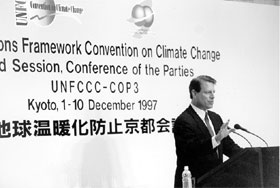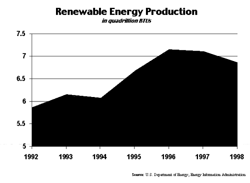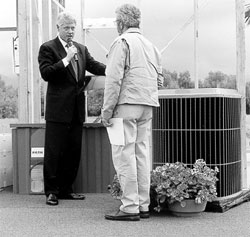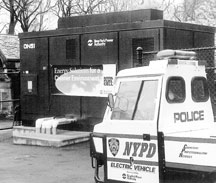
|
|||||||||||||||||||||||||||||||||||||||||||||||
|
Meeting the Challenge of Global Warming
President Clinton and Vice President Gore are leading efforts — in the United States and abroad — to protect future generations from these grave risks. At home, the Administration has launched major new initiatives to improve energy efficiency and develop clean, renewable energy sources — steps that will reduce greenhouse gas emissions while saving money and creating jobs. On the diplomatic front, the United States is working with other nations to create cost-effective solutions and to ensure that all nations join in meeting this global challenge. Sound, common-sense approaches to climate change will help put the United States and other nations on the path to a clean energy future, ensuring a healthier environment while creating new opportunities for strong, sustainable growth. Forging Strong, Sensible International Agreement Climate change is a global challenge that requires a global solution. In 1997, with critical leadership from Vice President Gore, representatives of more than 160 nations agreed on the basic architecture of an international strategy to combat global warming. This historic agreement, called the Kyoto Protocol, sets strong, realistic targets for reducing greenhouse gas emissions from industrialized countries, and establishes flexible, market-based mechanisms to achieve them as cost-effectively as possible. The Kyoto Protocol remains a work in progress. Through ongoing negotiations, the Administration is working with other nations to turn the treaty's broad concepts into working realities. The Administration also is pursuing an aggressive diplomatic strategy to achieve broader participation by developing countries in this global effort. The President and Vice President are committed to completing the important work begun in Kyoto so this important treaty can be ratified. Improving Our Scientific Understanding Our strategy for addressing global warming must be founded on the best possible science. Since 1993, the Administration has secured $11.6 billion for the United States Global Change Research Program, which works to strengthen our understanding of the human and natural forces that influence the Earth's climate, and the potential impacts of global warming. Key priorities have included improved surface and satellite monitoring of changes in temperature and precipitation; expanded research into the effects of climate change on the natural and built environment; and a better understanding of the role of farms, forests, and other natural or managed lands in capturing and storing carbon.
Investing in Clean Energy Technologies New technologies that improve energy efficiency and provide clean, renewable energy hold great promise for curbing greenhouse gas emissions. They also can ease our reliance on imported oil, reduce other forms of harmful air pollution, and provide significant long-term savings for businesses and consumers. To help spur these advances, President Clinton launched the Climate Change Technology Initiative, a comprehensive program of research investments and targeted tax incentives. Over the past two years, the President has secured more than $2 billion to research and develop clean energy technologies in the four major carbon-emitting sectors of the economy — buildings, transportation, industry, and electricity generation. The President also has proposed $4 billion in tax credits over five years for wind and biomass energy production, and for the purchase of energy-efficient homes and appliances, solar energy systems, electric and hybrid vehicles, and other clean energy products. Forging Partnerships with Industry The Administration has forged new partnerships with major industries to promote voluntary, cost-effective efforts that can achieve significant reductions in greenhouse gas emissions. These include:
Growing Clean Energy Promising new bio-based technologies convert crops, trees, farm waste and other "biomass" into a vast array of fuels and products. These new technologies will help reduce greenhouse gas emissions while enhancing U.S. energy security and creating new economic opportunity for farmers and others. President Clinton issued an Executive Order last year to coordinate federal efforts to spur the development of bio-based technologies and move them from the laboratory to the marketplace. The President also set a goal of tripling America's use of bioenergy and bioproducts by 2010. Achieving this goal could generate $15 billion to $20 billion in new income for farmers and rural communities, and reduce greenhouse gas emissions by up to 100 million tons a year — the equivalent of taking 70 million cars off the road. Million Solar Roofs In June 1997, President Clinton launched the Million Solar Roofs Initiative, with the goal of installing solar energy systems on one million U.S. roofs by 2010. Meeting this goal will reduce carbon emissions equivalent to the annual emissions of 850,000 cars, while creating high-tech jobs and increasing domestic production of solar technologies. The initiative is well ahead of schedule: the Department of Energy already has received commitments for close to a million solar roofs. To further spur solar energy technologies, the President has proposed a 15 percent tax credit (up to $2,000) for the purchase of rooftop solar systems. Wind Powering America Wind is the fastest growing source of energy in the world. Dramatic improvements in wind turbine technology helped spur a 25 percent increase in wind-generating capacity over the last decade. Federal researchers, working in collaboration with private industry, are helping to develop the next generation of wind turbines, which will make wind energy even more competitive. Currently, the U.S. has an installed capacity of about 2500 megawatts of wind energy — enough to power about half a million homes. The Wind Powering America Initiative, launched last year, sets a goal of generating five percent of U.S. electricity with wind power by 2020.
Saving Energy and Money At Home Roughly a fifth of the energy consumed in the United States is used to power our homes, nearly all of it for appliances. The Administration has issued new energy-efficiency standards for heating and cooling equipment, water heaters, refrigerators, and clothes washers and dryers. By 2010, these energy conservation measures will have saved consumers more than $40 billion and avoided cumulative greenhouse gas emissions of nearly 190 million metric tons.
Los Angeles, California The walls are super-insulated. Innovative new windows do a better job of keeping the heat and cold out. Rooftop solar panels provide much of the electricity needed. And the homeowners are saving 50 percent or more on their energy bills. These homes of the future are here today, in the path-breaking Village Green development in Los Angeles' San Fernando Valley. Families began moving into the first 22 of 186 planned homes last year, just about a year after President Clinton visited the site to launch the Administration's Partnership for Advancing Technology in Housing (PATH). Through PATH, federal agencies work with America's building industry to speed the creation and use of advanced technologies that can radically improve the quality, durability, energy efficiency, environmental performance and affordability of the nation's housing. Village Green is one of five PATH pilot projects around the country.
The new homes at Village Green are already demonstrating the environmental and economic benefits of "green" construction. "Village Green," said Los Angeles Councilwoman Ruth Galanter, "is living proof that the building industry can combine new environmental technologies with affordable housing right here in one of the largest housing markets in the nation."
New York, New York Amid the steel and concrete of Manhattan, Central Park has long been a treasured oasis of green. And now, green energy powers the park's only police station. Without additional electricity, the Civil War vintage precinct house would not have been able to operate digital fingerprinting equipment, or even keep its air conditioner running. But the most obvious source, a new underground power line, would have been costly and disruptive. The answer was a fuel cell - an ultraclean electric-generating technology that could be installed in a corner of the station's parking lot. Powered by natural gas from an existing line, NYPD's quiet, efficient
The technology behind the fuel cell was developed through a partnership between the Department of Energy and International Fuel Cells, Inc. of South Windsor, Connecticut. The federal government paid one-third of the installation cost as part of a program to encourage use of this innovative technology, which is supplying clean power to a growing number of energy users across the nation and overseas.
To comment on this service, |
|||||||||||||||||||||||||||||||||||||||||||||||




